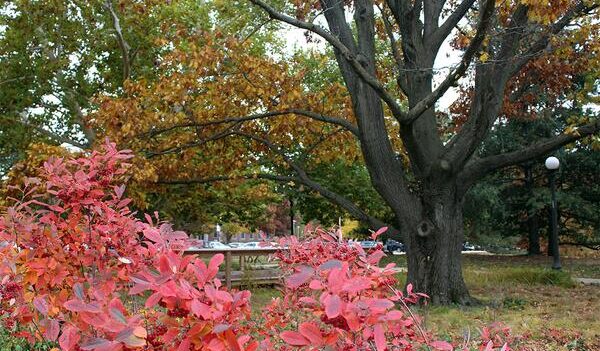
Nestled in the pedestrian walkways leading from Illini Grove to the larger University of Illinois Urbana-Champaign campus, Illinois Extension’s 10,000-square-foot Red Oak Rain Garden is an inviting demonstration site that first began to take shape in 2006 to address flooding issues that threatened pathways and a large red oak tree. It has continued to evolve through collaborative efforts and multiple funding sources including campus Facilities & Services, the Student Sustainability Committee, the Illinois Clean Energy Community Foundation, Champaign County Design and Conversation Foundation, and partnership with Extension’s Champaign County Master Gardeners and East Central Illinois Master Naturalists.
Direct, individual donor support is also a vital component of sustaining the garden. University of Illinois Urbana-Champaign alumnae Karen Folk and her husband, Michael, who pledged $25,000 in funding toward Red Oak Rain Garden, shared, “Red Oak Rain Garden’s transformation from a barren, littered campus space to a beautiful garden and effective stormwater management system has been inspiring. Its long-term maintenance is important to us because it has also become a learning environment for students, volunteers, and the wider community. We hope that our gift will inspire others to contribute to keeping this a space of natural beauty for all to enjoy.”
Recently, Mrs. Jean Bollero Lawyer of Heyworth, joined this group of committed partners by contributing a gift of $5,000 toward the continued maintenance and improvement of Red Oak Rain Garden. Mrs. Lawyer shared her gift inspiration, “Much of my undergrad experience at University of Illinois took place outdoors, as I walked around the beautiful campus. I found that fresh air, beautiful sights, and yes — walking had a positive impact on my sense of well-being. Fifty years later, I want to help provide that same experience to others. There is so much we can learn from nature as well as in the classroom.”
C. Eliana Brown, water quality and stormwater specialist with Illinois-Indiana Sea Grant and Illinois Extension, who serves as director of the rain garden, remarked, “generous gifts like these are important because they allow us to maintain this haven for people and wildlife in perpetuity and ensure that both the habitat and the day-to-day function are optimized.”
Visitors and those hustling over the boardwalk bridge on their way to and from campus get a sense of well-being from the sustainable landscape, which features over 9,000 native plants, wildlife habitation (including pollinators and avian residents), a footbridge made from sustainably harvested wood from Allerton Park, and small sculptural elements that all work in harmony to create a beautiful and smart space that addresses an area that would otherwise be prone to flooding. The rain garden’s native plants and soil absorb and filter rainwater runoff, which mitigates flooding and improves water quality. The garden is certified as a Monarch Watch butterfly waystation and bird-friendly by the National Audubon Society. Both landscape architecture and horticultural classes regularly visit the space, as well as little ones from the Child Development Lab.
To stay up to date, follow Red Oak Rain Garden on Twitter, Facebook, or Instagram.
Become a donor
Invest today in programs that are transforming our world. https://extension.illinois.edu/giftpage
Become a volunteer
Interested in learning about rain garden care and native plants? Workdays are 9 to 11 a.m. Fridays. If you’re interested in volunteering, email uie-RedOakRainGarden@illinois.edu.
Ready to start a rain garden?
Get started with these Illinois Extension resources:
- Native plant resources
- Prevent floods with rain-friendly landscaping
- Homeowner Conservation Practices to Protect Water Quality (Purdue University)
Illinois-Indiana Sea Grant is a partnership between NOAA, University of Illinois Extension, and Purdue University Forestry and Natural Resources, bringing science together with communities for solutions that work. Sea Grant is a network of 34 science, education and outreach programs located in every coastal and Great Lakes state, Lake Champlain, Puerto Rico and Guam.
Contact: C. Eliana Brown, water quality and stormwater specialist, Illinois-Indiana See Grant and Illinois Extension
Writer: Emily Steele, media communications manager, Illinois Extension
Source: Illinois Extension News

